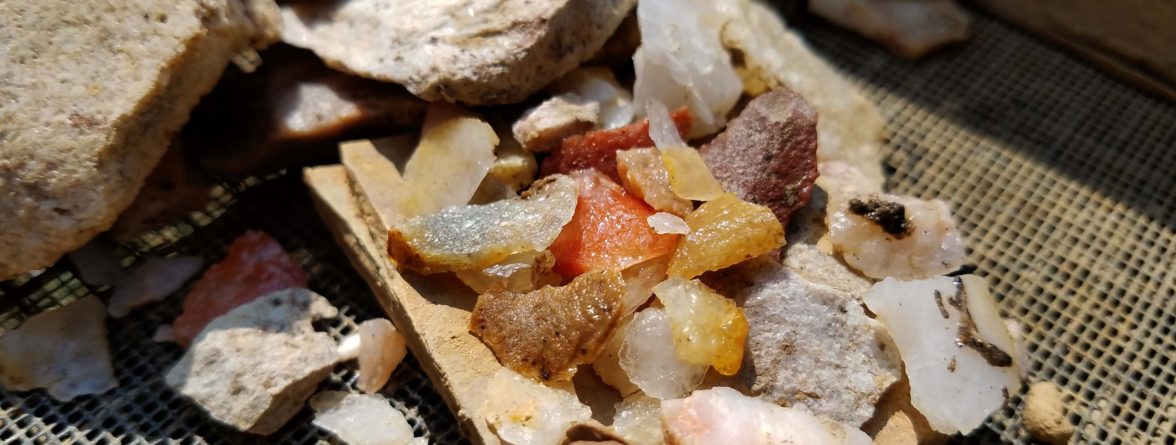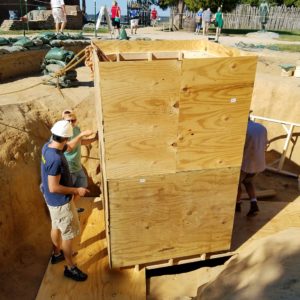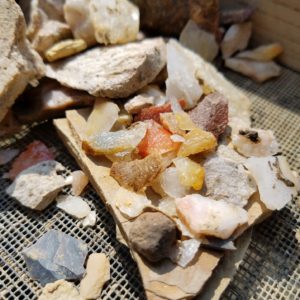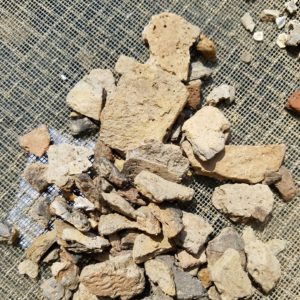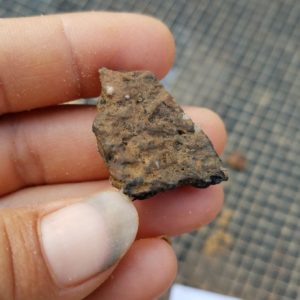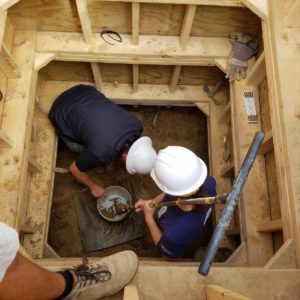After two years of excavations into the cellar located at the corner of James Fort’s 1608 addition, the team finally focused on excavating the well within its walls.
While this well showed similar characteristics of two early wells previously excavated by the team in 2006 and 2009, the story it told was as very different. Similar to the John Smith well in the fort’s center, the well shaft was dug in the bottom of a cellar. Also, because it was identical to the 5 foot by 5 foot square well built in 1611 in the fort’s north corner, the team also assumed that this well would have a wooden lining. Both of these previously excavated wells held thousands of artifacts. However, this well was almost completely deficient of artifacts and had nothing lining its interior.
Interestingly, the only artifacts that the team recovered from the well fill were in a layer of redeposited prehistoric topsoil. That layer produced beautiful quartzite flakes, related to the production of projectile points, and native pottery dated to hundreds of years before the colonists’ arrival at Jamestown. The remaining layers were a mix of clay and sand subsoil, which were likely gathered during cellar expansion. Only a few historic artifacts were found. It contained one small piece of lead shot and some fragments of brick.
“As we went through the well fill, we were struck by the absence of artifacts. After the well was abandoned, the colonists did not use it to dispose of their trash. As they expanded the cellar, they quickly used the undisturbed topsoil and subsoil they were removing from the side walls to fill in the well shaft,” archaeologist Mary Anna Hartley explained.
The fact that there was no lining to hold back the sandy soil in the walls of the well shaft led senior staff archaeologist Dave Givens to hypothesize that the colonists may have dug the well shaft during a period of drought and felt that a well casing was unnecessary. Without a lining, any rain event that they experienced would have caused heavy erosion to the shaft’s subsoil walls as the water level rose. This is very similar to when you dig a hole in the sand at the beach and the sides slump in at the level you hit water.
The absence of artifacts in the well appears to indicate that it was filled quickly and likely abandoned very soon after it was dug. It also indicates that it was filled very early. So while the well held very little cultural material it still told us a story about the life of the cellar and the early fort-period. For more information on the well, check out the link to our Dig Update video featuring Dave Givens.
related images
- The crew works to put in the well ring in the well shaft to protect them as they dig deeper.
- Danny Schmidt, Mary Anna Hartley, and Don Warmke excavating the east half of the well.
- Fisheye view of the top of the well ring.
- Fisheye view of the well ring.
- The dark stain in the well profile is redeposited prehistoric layer, containing flakes and Native pottery existing on site before the colonists arrived.
- Quartzite flakes found in the well that were in the soil that colonists gathered to fill their well.
- Native pottery found in the well.
- Prince George ware found in the well.
- Bob Chartrand removes the west profile down to the water table.
- Dave Givens and Hannah Gatz-Miller, NPS Geoscientist-in-the-park, auger where the team stopped seeing cultural material to ascertain if they have reached the bottom of the well.
- Dave Givens and Hannah Gatz-Miller, NPS Geoscientist-in-the-park, auger where archaeologists stopped seeing cultural material to ascertain if they have reached the bottom of the well.
- Auger showing how clean the sand fill is in the bottom of the well.
- Danny Schmidt and Dave Givens reflected in the well water.


